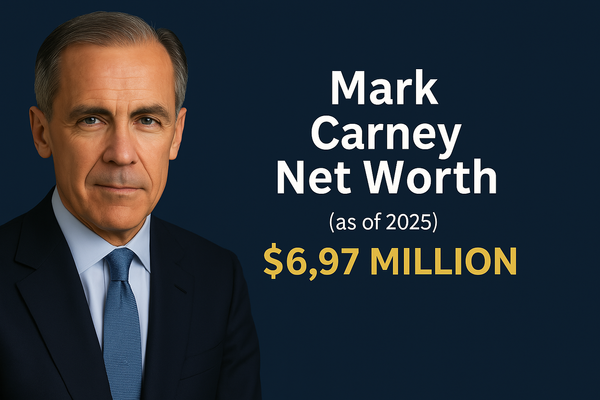Mark Carney's Net Worth Revealed: Inside the Financial Success of Canada's Former Top Banker
Mark Carney's net worth has reached an impressive $6.97 million in 2025. His remarkable career spans both public service and private sector achievements. His path to wealth creation began at Goldman Sachs, where he climbed the corporate ladder over 13 years to become managing director of investment banking.
His financial success grew steadily through his career moves. The Bank of Canada role brought him CAD $432,000 yearly, followed by a hefty £800,000 package at the Bank of England. Today, he holds a lucrative position at Brookfield Asset Management with stock options worth US$6.8 million and rights to 409,300 shares. Let's get into how Canada's former top banker built his wealth through calculated career decisions and astute financial choices.
Mark Carney's Early Career and First Financial Gains
Mark Carney's path to financial success started with his remarkable education and early career choices. He took a different route than most central bankers who spend their careers in public service. Instead, Carney built his wealth in the private sector before moving to government positions.
Harvard education and early investment banking
Carney left Edmonton in 1983 to start his academic life at Harvard University with a scholarship. His passion for economics grew at Harvard, thanks in part to lectures from fellow Canadian economist John Kenneth Galbraith. He balanced his studies with sports and played as backup goalie for Harvard's hockey team. His hard work paid off with a first-class honors bachelor's degree in economics in 1988.
Right after Harvard, Carney joined Goldman Sachs International in London in 1988. This first role opened his eyes to high finance, but he knew he needed more education. After two years at Goldman's Tokyo office from 1990 to 1991, he took time off to study at Oxford University. There, he earned his master's degree in 1993 and doctorate in economics in 1995. His doctoral research looked at how domestic competition could boost national economic competitiveness.
13-year tenure at Goldman Sachs
After finishing his PhD, Carney went back to Goldman Sachs and started what became a 13-year career with the investment banking giant. He worked in several global offices:
- London (1995): Co-head of sovereign risk
- New York (1998): Corporate finance and M&A
- Toronto (2000-2003): Final years at Goldman
His Goldman years coincided with major global financial events. As co-head of sovereign risk, he dealt with the 1997 Asian financial crisis and the Russian financial crisis that led to the collapse of hedge fund Long Term Capital Management (LTCM).
Carney's work around the world included some notable achievements that showed his financial expertise. He helped South Africa access international bond markets after apartheid and advised Russia during its 1998 financial crisis. These high-profile projects proved his skill at handling complex financial situations while growing his personal wealth.
Earnings as managing director of investment banking
Carney's expertise earned him a promotion to Managing Director of Investment Banking at Goldman's Toronto office in 2002. This senior role marked the peak of his private sector career and brought substantial financial rewards.
His investment banking years helped him build what he later called "a fortune". Managing directors at Goldman Sachs usually earned seven-figure packages that included base salary, bonuses, and stock options, though specific numbers from this time remain private.
Carney was close to becoming a partner at Goldman Sachs—a highly sought-after position that would have made him even wealthier—when he made an unexpected move. He left his profitable banking career in 2003 to join the Bank of Canada as a deputy governor.
He reflected on this choice later: "I was on the edge of being a partner at Goldman Sachs, which is a very lucrative role, and I chose to leave that role to be a deputy governor of the Bank of Canada, which is not a glory job, and it's not a particularly well-paid job".
Though he walked away from potential private sector wealth, Carney had already built a strong financial foundation during his Goldman years. This financial security let him take on public service roles where he would direct monetary policy through global economic challenges, first at the Bank of Canada and later at the Bank of England.
Wealth Growth During Bank of Canada Years (2008-2013)
Mark Carney left his lucrative position at Goldman Sachs to become Governor of the Bank of Canada in February 2008. His five-and-a-half-year tenure substantially changed his financial portfolio and Canada's economic path.
Salary and compensation package
Carney's earnings as Canada's central bank leader were substantial. Official records show his compensation grew from CAD 482,938 to CAD 714,793 by 2013. Another source puts his annual earnings at CAD 601,931. These figures, while impressive, were nowhere near his investment banking compensation at Goldman Sachs.
His time in public service ended up improving mark carney's net worth through added credibility and experience. This paved the way for much higher earnings in future roles. The Bank of Canada's compensation, though generous by public sector standards, was modest compared to his future Bank of England earnings.
Financial decisions during the 2008 crisis
Carney showed remarkable foresight right from the start at the Bank of Canada. He made a bold move to cut interest rates by 50 basis points in March 2008, just one month into his role. Most central banks thought the financial crisis would fade naturally at that time—the European Central Bank even raised rates during this period.
The global financial situation got worse, so Carney launched an innovative "conditional commitment" approach in April 2009. This strategy gave clear guidance about future interest rate paths and promised to keep the record-low rate of 0.25% until the second quarter of 2010[102]. Monetary economist Michael Woodford later noted that this new language "had a noticeable effect on market-based expectations of future policy".
These decisive actions helped Canada handle the financial crisis better than other G7 nations. Canada became the first G7 country to recover its pre-crisis GDP levels. Economic growth bounced back to 3.2% in 2010 after dropping 2.8% in 2009.
Investment strategies while guiding Canada's economy
Carney managed to keep a careful balance between boosting economic activity and ensuring long-term stability. His strategies included:
- Creating new emergency loan facilities to maintain market liquidity
- Implementing nonstandard monetary tools when policy rates hit the effective lower bound
- Coordinating with international institutions to monitor systemic risk
These approaches made Canada the only G7 country that didn't use taxpayer money to bail out banks. Canada's economy grew nearly 5% during Carney's five-year tenure, while inflation stayed controlled at an average of 1.7%.
In spite of that, some economists say Carney's policies led to a concerning housing market boom. His commitment to low interest rates encouraged Canadians to take out mortgages. This propelled development in construction that some critics say damaged his legacy. The Canadian government had to tighten mortgage lending rules four times over five years to cool the faster appreciating housing market.
Carney's departure from the Bank of Canada in June 2013 saw his net worth in Canadian dollars grow modestly through his salary. The true financial value of this period would show in his later roles, where his compensation increased dramatically based on his reputation from directing Canada through economic turbulence.
Bank of England Tenure: Peak Earning Period
Mark Carney became the first foreign governor of the Bank of England in 2013, after its 320-year history. This appointment came with a financial package that boosted his mark carney net worth. His time at the helm turned out to be the most profitable period of his public service career.
Record-breaking £800,000 compensation
The compensation package Carney negotiated reached nearly £874,000 per year, making him one of Britain's highest-paid public servants. His basic salary of £480,000 was much higher than the £305,000 his predecessor, Sir Mervyn King, earned. The package also included pension contributions worth £144,000. This compensation put him in the same league as directors of the UK's 250 biggest companies. Yet, it stayed well below private sector banking salaries where top finance directors could earn more than £1 million.
British MPs asked Carney about his compensation. He defended it by comparing his total package to Sir Mervyn King's "pay and pension basis". Plus, he noted that the role now included more bank regulation duties.
Housing allowance and relocation benefits
The most debated part of Carney's package was his yearly £250,000 housing allowance. This benefit helped maintain his family's living standards as they moved from Ottawa to London. "I'm moving from one of the least expensive capital cities in the world—Ottawa—to one of the most expensive capital cities in the world," Carney explained.
His relocation package included £102,816 in moving expenses. This covered business-class flights for him and economy-class flights for his family and school-hunting trips. British taxpayers criticized these benefits, given the government's 1% cap on public sector wage increases.
Wealth management during Brexit uncertainty
Carney faced major economic challenges during his time at the Bank of England. The 2016 Brexit referendum proved to be his "toughest day" on the job. Right after the vote, as the pound dropped, he spoke to reassure markets and put contingency plans into action that "worked effectively".
He managed the economy by cutting interest rates from 0.5% to 0.25% and started quantitative easing again. He used "forward guidance" policies and promised not to raise rates until specific economic conditions improved.
Markets stabilized under his leadership during political turmoil, but Brexit supporters criticized his warnings about economic risks. Conservative lawmaker Jacob Rees-Mogg called him the "high priest of project fear". Carney stood firm, saying it was his job to point out financial risks.
Private Sector Return: Brookfield and Bloomberg
Mark Carney went back to the private sector in 2020 after his time at the Bank of England. His mark carney net worth grew substantially through executive roles at two major financial institutions.
Stock options worth $6.8 million at Brookfield
Carney landed substantial financial benefits as chair and head of transition investing at Brookfield Asset Management. His holdings included options on 409,300 shares with an average strike price of CAD 52.31. These options were worth about CAD 9.47 million as of December 2024. The unexercised stock options would not expire until 2033 and 2034.
Brookfield kept parts of Carney's compensation package private. Documents show that he shared CAD 10.45 million in salaries and cash bonuses with executives Sam Pollock and Cyrus Madon. He could also earn "carried interest" - performance bonuses - from his role in managing major investment funds.
Bloomberg board chairmanship compensation
Carney added to his corporate roles by becoming Bloomberg LP's board chairman. Bloomberg operates as a private company, so they don't reveal specific compensation for this position. This prestigious role boosted his mark carney net worth in canadian dollars.
ESG investment leadership and financial gains
Carney's wealth grew largely through his leadership in environmental, social, and governance (ESG) investments. He led transition investing at Brookfield and focused on environmentally responsible finance initiatives. The company raised more than USD 34.83 billion for net-zero transition funds under his guidance.
His investment strategy covered renewable power, business transformation, carbon capture, and nuclear energy across the globe. He promoted climate-focused investments as value creators, saying: "Private finance is judging which companies are part of the solution".
Carney stepped down from his corporate positions in January 2025 to pursue political goals. He moved his assets, including valuable stock options, into a blind trust when he became Prime Minister. Opposition parties now want more transparency about his Brookfield connections and possible conflicts of interest.
Current Net Worth Analysis in 2025
Mark Carney's financial status has captured public attention as he steps into the role of Prime Minister in 2025. A close look at his finances reveals his wealth and shows how he handles potential conflicts of interest in his new leadership position.
Total estimated wealth of $5-7 million
Financial reports show mark carney net worth stands at CAD 9.71 million in 2025. Pierre Poilievre News made this assessment, which many financial publications have cited. Other analysts suggest his wealth could range between CAD 6.97 million and CAD 13.93 million. This wide range reflects how hard it is to value his diverse asset portfolio accurately.
His wealth comes from several sources. Financial records show he owned CAD 9.47 million in Brookfield Asset Management stock options by December 2024. These options included 209,300 shares at CAD 48.95 and 200,000 options at CAD 55.83. The expiration dates run through 2033-2034. He also owned 41,337 shares worth about CAD 4.18 million.
Comparison to other central bankers
Carney's financial portfolio stands out among former central bankers. His wealth is nowhere near what he could have made if he stayed in private finance full-time. He acknowledged this in 2021: "If I wanted to maximize my net present value, I'd be sitting on top of some pile of capital".
Most central bankers move between academic and public service roles. Carney's path through Goldman Sachs, central banking, and private equity at Brookfield created a unique wealth profile. His CAD 9.71 million net worth in canadian dollars is more than most career central bankers have, but doesn't match corporate finance executives' wealth.
Assets in blind trust as Prime Minister
Carney moved his financial assets into a blind trust after winning the Liberal leadership. This ethical firewall means a trustee now manages his assets without his input[221]. The trustee can't ask for his advice or share details about ongoing transactions.
Government ethics rules let Carney know his assets' overall worth but block him from knowing specific investment decisions. The trust must file annual reports with the ethics commissioner by March 31. These reports confirm the trust's worth, income, and trustee fees.
Carney knows which assets went into the trust since the transfer happened just recently. This arrangement will stay in place while he serves in public office.
Conclusion
Mark Carney's financial experience shows how smart career choices in both private and public sectors can pay off. He started at Goldman Sachs, moved to central banking leadership, and returned to private equity. His wealth growth came from calculated decisions, not luck.
His current net worth sits at CAD 9.71 million. This might not match top finance executives' wealth, but it shows what he achieved during his time in public service. He almost made partner at Goldman Sachs, yet he chose public service over potentially greater private sector wealth. This choice reveals his character.
His recent move into politics creates new challenges. He put his assets in a blind trust while serving as Prime Minister to ensure ethical leadership. His experience in both private and public sectors makes him different from other political leaders.
Carney's financial success teaches us how to balance career goals with public service effectively. His path shows that leaders can achieve financial success without compromising their principles. Clear vision and strategic thinking make this possible.
FAQs
Q1. What is Mark Carney's estimated net worth in 2025? Mark Carney's net worth is estimated to be around CAD 9.71 million as of 2025, though some analysts suggest it could range between CAD 6.97 million and CAD 13.93 million.
Q2. How did Mark Carney accumulate his wealth? Carney built his wealth through a diverse career, starting with 13 years at Goldman Sachs, followed by leadership roles at the Bank of Canada and Bank of England, and later through executive positions at Brookfield Asset Management and Bloomberg.
Q3. What was Mark Carney's highest-paying position? Carney's tenure as Governor of the Bank of England was his peak earning period in public service, with a compensation package totaling nearly £874,000 annually, including a £480,000 base salary and a controversial £250,000 housing allowance.
Q4. How is Mark Carney managing potential conflicts of interest as Prime Minister? Upon becoming Prime Minister in 2025, Carney transferred his financial assets, including valuable stock options, into a blind trust to avoid potential conflicts of interest while in office.
Q5. How does Mark Carney's wealth compare to other central bankers? Carney's net worth exceeds that of most career central bankers due to his unique career path through investment banking and private equity. However, it remains modest compared to top corporate finance executives.


